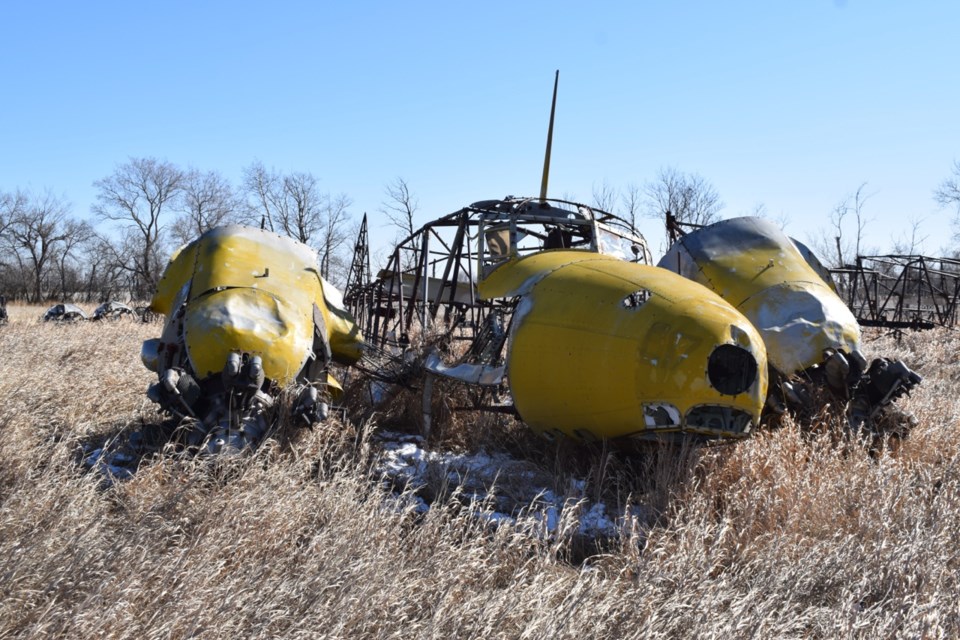The search for military-time planes by Estevan's Lester Hinzman resulted in many interesting discoveries.
With the help of other people, he was able to find dozens of Avro Ansons that were utilized for training purposes during the Second World War. Many historic relics were spread all around the southeast corner of the province, but one big collection he came across was put together by Oxbow's Terry Fraser.
The private open-air museum once featured about 40 old planes, or what's left of them.
Back in the late 1970s and early 1980s, Fraser and his brother were hoping to have enough parts to one day rebuild a machine that they would be able to take up to the skies again. That never happened, but the collection they gathered on the property in the Oxbow area preserves local history.
Most of these planes were sold out of the old Estevan airport. Some also came from Weyburn and a few pieces they acquired from out of the province.
After the war, many local farmers bought written-off aircraft to utilize in their operations.
"A lot of farmers bought them for next to nothing. And we never had one, so we went around and bought them up from farmers," Fraser said. "When they auctioned them off, they went anywhere from $40. But the most I ever heard anybody paying for them was $250 or something like that."
The family rescued what they could, but some of the machines were already completely lost.
"We went and looked at some farmyards for the historical ones but there was absolutely nothing left, just bumped into the ground by cows or something," Fraser recalled.
The collection features parts and pieces of not only the Avro Ansons, but also the Cessna Crane, Fairchild Cornell and Bristol Bollingbroke.
The Estevan war-time airbase would mainly utilize Avro Ansons for training purposes. It was one of nearly 200 flying schools organized in Saskatchewan to cover the needs for military pilots in 1940-45.
The Avro Ansons, planes originating from Great Britain, were primarily used for navigational training after С����Ƶ deemed obsolete in frontline combat operations shortly after the end of the Second World War. Cessna Cranes were used by the Royal Canadian Air Force (RCAF) to supplement its Avro Ansons arriving from England and were utilized in Western Canada to teach pilots to fly multi-engined planes.
Fairchild Cornells were flown at many of the Elementary Flying Training Schools of the British Commonwealth Air Training Plan. According to the Bomber Command Museum of Canada's website, 1,642 planes of this kind were constructed in Canada and used as trainers for the duration of the Second World War. The Estevan base mainly used Avro Ansons, but several Cornells were stored here towards the end of the war.
Parts of the Bolingbroke Fraser have come from Manitoba. These planes served as patrol bombers on the Canadian Atlantic and Pacific coasts in 1940-44, and were also used as a trainer by the RCAF.
Once the need for training the pilots for the war remained in the past, the planes were sold to the general population. Often, they would lose wings up to the engines right at the airport for easier transportation. That was the case with all the planes that came from Estevan as they had to go through the cement bridge, and with wings, they would be too wide to fit.
The centrepiece of Fraser's open-air museum – the Avro Anson – is still sitting on its wheels and is in better shape than most of the pieces. It was towed to the property from the Estevan area. Fraser said bringing all these planes to one yard was an adventure of its own.
"We've travelled down the road in the middle of the night with some of those loads. And we had policemen passing us shaking their heads," he recalled.
Most people bought the machines to use around the farms or yards for anything but flying. However, for Fraser and his brother, the reason for acquiring this collection was different.
"We were interested in flying in general and they were interesting things to have," Fraser said. "We imagined we might find enough pieces to come close to building one, but it was too expensive."
By the time Fraser started buying the planes, most of them wouldn't have motors, and would also miss a lot of other pieces. He was collecting the relics for about six to seven years, and he said they probably came close to having all metal parts needed for putting one plane together, but wooden parts were already gone.
With the cost of rebuilding a plane that would be flyable С����Ƶ too high, the project never came to fruition. The family just studied what they acquired and tinkered what they could, and eventually, the collection turned into a spontaneous open-air private exhibition.
Fraser said his cousin was a tail gunner and a bomber, who took some of his training in Manitoba, then went through the Second World War and returned home. He shared his experiences with his family, but military planes weren't his thing anymore.
"He would never get in an airplane again," Fraser said.
A wildland fire went through the museum in 2011, destroying the remaining combustible parts of the planes and leaving the collection in a poor shape. However, before the fire, Fraser shipped parts and even a full plane to different museums and private collectors across Canada. They worked a lot with museums in Brandon and Calgary.
While many planes that Fraser collected at his property now have nothing but the frames left, Hinzman said that these remnants remain important historic evidence. They serve as a reminder of the local input in fighting and winning the war, tell the story of the feat of predecessors and teach new generations about the past of the area.




